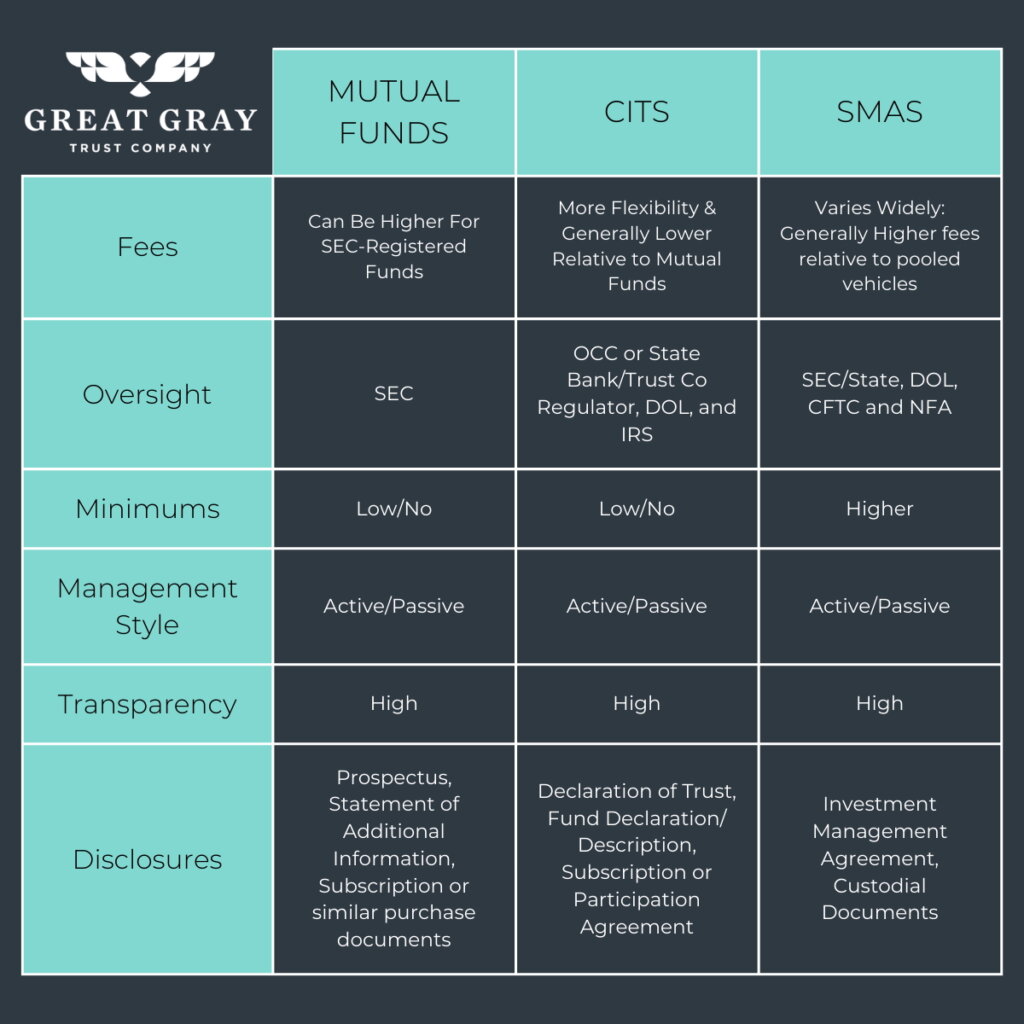CITs vs. Mutual Funds, According to an ERISA Expert
by Jason Levy – Sr. Counsel at Great Gray
The rapid growth of collective investment trusts (CITs) has reached a significant milestone. The Callan Institute recently reported that CITs have overtaken mutual funds as the most popular investment vehicle in defined contribution retirement plans. Today, 82% of defined contribution plans are using CITs. This shift is driven by several key factors that contribute to the growing popularity of CITs.
Why CITs Are Gaining Traction in Retirement Plans
CITs are a strictly regulated pooled investment vehicle, often offering meaningful cost savings over traditional mutual funds. In addition, the removal or reduction of minimum asset thresholds has made CITs more accessible than ever, further contributing to their widespread adoption.
The Shift: from Mutual Funds to CITs
In my previous role at a large law firm as an ERISA attorney advising retirement plans, I had a front-row seat to this significant change in the retirement investment landscape. As investment minimums declined, it became increasingly common for an investment advisor to recommend a CIT offering the same investment strategy and manager as an existing mutual fund, but at a significantly reduced cost.
The Impact of CITs on Retirement Savings
While the cost savings from CITs may seem small at first, they compound over time and can result in substantial improvements in retirement outcomes. According to the U.S. Department of Labor, over a 35-year career, a 1% (100 basis point) difference in fees and expenses can reduce an individual’s retirement savings by 28% – a $280,000 difference on a $1 million investment.
Educating Retirement Plan Decisionmakers and Advisors
Despite the prevalence of CITs today, some retirement plan decisionmakers and advisors remain unfamiliar with these investment vehicles. This is understandable, as only a few years ago, CITs were primarily accessible to the largest plans. To help bridge this knowledge gap, we’ve created the infographic below, designed to guide those new to CITs.
The Responsibility of Retirement Plan Decisionmakers
Responsible decision makers and advisors should select investment options that maximize risk-adjusted returns for plan participants – and, as part of that determination, should focus on choosing the right investment vehicle. This infographic provides a comparison of the common types of investment vehicles available for retirement plan lineups to help better understand the choices.

Stay tuned for part 2 of this blog post, where we’ll dive deeper into how CITs fit into this landscape.
Great Gray Trust Company, LLC Collective Investment Funds (“Great Gray Funds”) are bank collective investment funds; they are not mutual funds. Great Gray Trust Company, LLC serves as the Trustee of the Great Gray Funds and maintains ultimate fiduciary authority over the management of, and investments made in, the Great Gray Funds. Great Gray Funds and their units are exempt from registration under the Investment Company Act of 1940 and the Securities Act of 1933, respectively.
Investments in the Great Gray Funds are not bank deposits or obligations of and are not insured or guaranteed by Great Gray Trust Company, LLC, any bank, the FDIC, the Federal Reserve, or any other governmental agency. The Great Gray Funds are commingled investment vehicles, and as such, the values of the underlying investments will rise and fall according to market activity; it is possible to lose money by investing in the Great Gray Funds.
Participation in Collective Investment Trust Funds is limited primarily to qualified retirement plans and certain state or local government plans and is not available to IRAs, health and welfare plans and, in certain cases, Keogh (H.R. 10) plans. Collective Investment Trust Funds may be suitable investments for plan fiduciaries seeking to construct a well-diversified retirement savings program. Investors should consider the investment objectives, risks, charges, and expenses of any pooled investment fund carefully before investing. The Additional Fund Information and Principal Risk Definitions (PRD) contains this and other information about a Collective Investment Trust Fund and is available at www.greatgray.com/cit-fund-info/principal-risk-definitions/ or ask for a free copy by contacting Great Gray Trust Company, LLC at (866) 427-6885.
Great Gray® and Great Gray Trust Company are service marks used in connection with various fiduciary and non-fiduciary services offered by Great Gray Trust Company, LLC.
